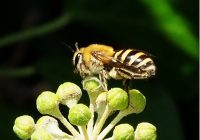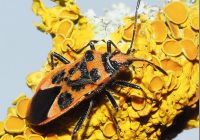Dr Phil Smith’s Wildlife Notes
September 2018
September was another relatively dry month. Although measurable rain fell on 12 days, there were significant amounts on only three dates. As a result, the sand-dune water-table at my Devil’s Hole measuring point continued to fall when it would usually be starting to re-charge. I had a letter published in the Radio Times pointing out that TV weather presenters are supposed to be educated people and should be aware that this country is only habitable because of regular reliable rainfall. Perhaps, therefore, they should stop perpetuating the myth that rain is bad. Evidently, they didn’t read it!
My wildlife observations this summer have been dominated by new sightings, especially of insects moving north in response to climate change. This month it was the Ivy Bee, a delightful solitary bee that was described new to science in 1993 and first arrived in southern England in 2001. Since then, it has spread rapidly, collecting pollen and nectar in autumn from flowering Ivy. Pete Kinsella contacted me on 14th to say he had found several at Blundellsands Key Park, so I joined him the following day and was delighted to spot a couple of these distinctive bees on a sunny patch of Ivy. Also there were two spectacular Hornet Hoverflies – our largest species. The park fence produced eight Red-legged Shieldbugs, a Birch Shieldbug and hundreds of Harlequin Ladybirds. Later, Pete found more Ivy Bees in the small parks on the east side of Crosby Marina. After several attempts, I found the first Formby specimen on a favourite Ivy patch at Ravenmeols. This also produced several Red Admirals, a few Commas, an uncommon fly Phasia hemiptera that parasitises shieldbugs and another Hornet Hoverfly. I have really got into hoverflies recently, partly because there are now excellent books to help identification and many can be named from photographs but also because new finds are possible. Pete tells me he has recorded 49 hoverflies in Sefton this year, including Eristalinus aeneus,a seaside specialist. However, one he missed is the brightly-coloured Didea fasciata which I photographed at Ravenmeols. Regional recorder, Glenn Rostron, reports that only four of this species have been identified in Cheshire and Lancashire since 2010, mine being the first for Formby since 1994.
Flies also featured on 17th, when I met Dipterist Phil Brighton on Birkdale Green Beach. While he netted flies for later identification, I found four species of shieldbugs: Hairy, Green, Gorse and Birch, together with two smart red-and-black Cinnamon Bugs (Corizus hyoscyami) another insect that has recently appeared in our region from the south. A familiar call alerted us to the first Pink-footed Goose overhead, a prelude to an enormous influx later in the month, thousands assembling on feeding grounds near Hightown and at Marshside.
Trevor Davenport joined me on one of several visits to the Devil’s Hole, Ravenmeols. Sweep-netting produced several Common and Slender Groundhoppers, these tiny relatives of grasshoppers being hard to find by visual searching.
Plant surveys continued during the month and I spent several hours measuring and labelling about 120 bushes of the rare hybrid willow Salix ×friesiana in the Devil’s Hole as part of a long-term project. A hunting Short-eared Owl was a welcome distraction on one of my trips. A visit to the northern Birkdale frontal dunes to search for Autumn Gentiansproduced a disappointing count of six where there were hundreds a few years ago. The reason is vegetation overgrowth following the decline of Rabbits. However, on the plus side, I did find a new patch of Baltic Rush in its only English locality and what appears to be a clump of hybrid Baltic Rush × Hard Rush. Critical examination will be needed next year, as this hybrid has only previously been recorded three times and is endemic to Britain.
The nationally Vulnerable Field Gentian was also in short supply on Ainsdale Sandhills Local Nature Reserve when I visited on 12th with Patricia Lockwood. However, there were other pleasing finds included Western Eyebright, Marsh Cinquefoil and Guernsey Fleabane. Most surprising were two large flowering spikes of Yucca on a high dune ridge. This can be invasive on dunes in southern Europe but is rare here. Loud calls alerted us to a worried Pheasant being chased by a Buzzard, which in turn was being mobbed by a Kestrel.
Joshua Styles’ Northwest Rare Plants Initiative to return extinct species grown from native seed to their former haunts led to Josh, Patricia and I planting 40 Heath Cudweeds at Birkdale Cemetery. This great rarity was last recorded there in 1928 by Fred Holder. More were introduced to another former site, the Montagu Road triangle, Freshfield. By the end of the month, the plants were well-established and doing well. Having received support from various conservation organisations, Josh has plans for many similar re-introductions to appropriately managed sites, turning the tide of losses from our native flora.




